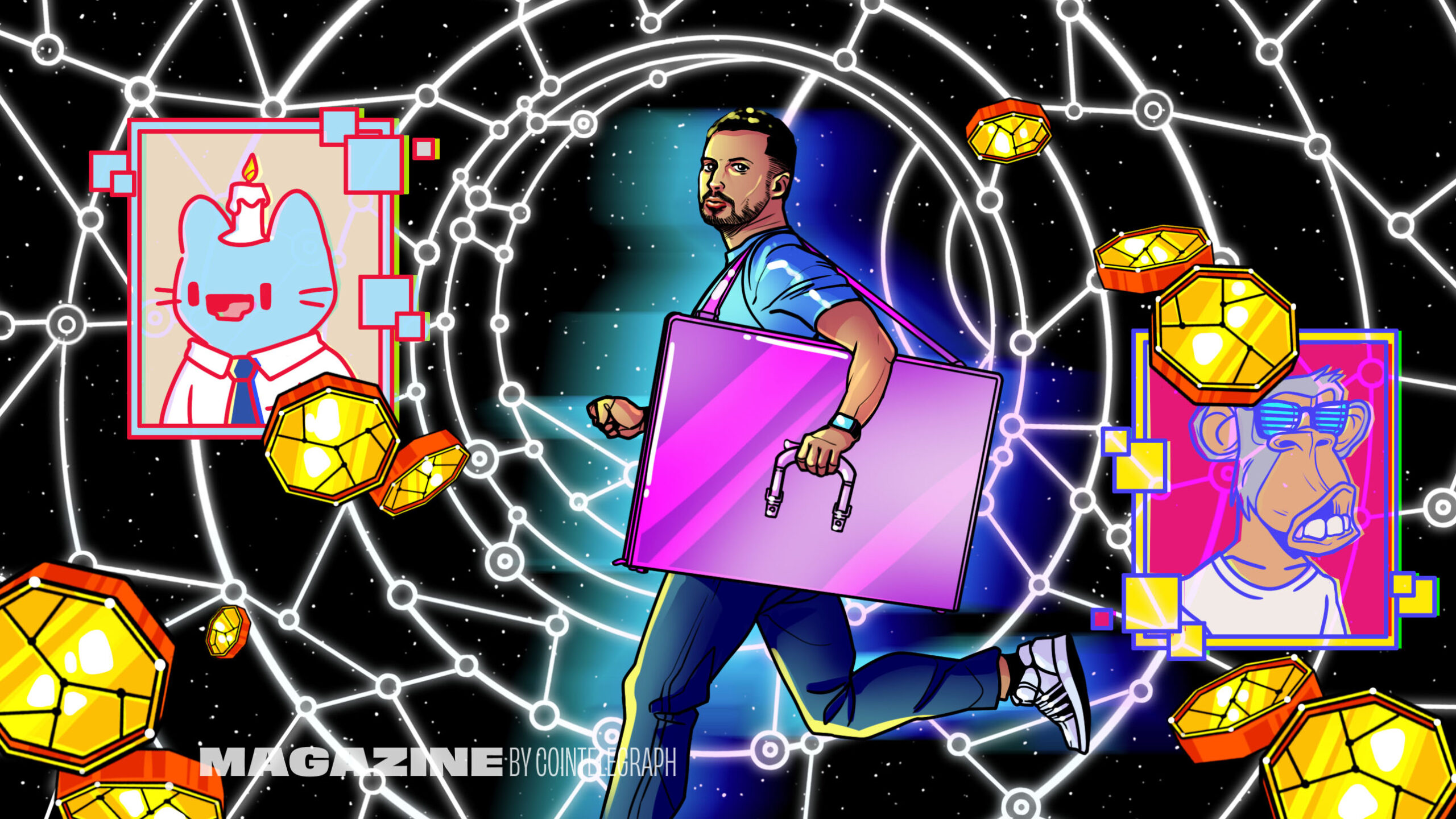Cryptocurrency
Journeys: Hervé Larren on Bitcoin, Apes and the psychology of ‘blue-chip’ NFTs

During a period of hyperinflation in 2013, “my Venezuelan mother asked me to send money to Caracas, the country’s capital,” Hervé Larren recalls. However, bank transfers were not possible between the two countries.
Busy with work in New York, he told a friend that he planned to fly to Caracas — carrying cash for his mother — and return the same day. “Why don’t you just send Bitcoin?” his friend asked, which quickly led to a change of plans as Larren made his first Bitcoin transfer.
“My first crypto transaction, in 2013, was to wire Bitcoin from the U.S. to Venezuela. Due to the economic collapse, there was no functioning banking system between these two countries.”
Switching from a career with luxury goods company LVMH Moët Hennessy Louis Vuitton, Larren co-founded a large-scale crypto mining operation and worked with Grayscale to bring crypto assets to old-school investors. He later became a key adviser to ApeCoin and the first person to bid a million dollars for a nonfungible token.
From old to new
“We were reporting to Nicolas Sarkozy, and he was coming to our meetings,” Larren recalls of his time as the head of a high school student council in Neuilly-sur-Seine, the wealthiest old-money suburb of Paris, where he grew up.
Sarkozy served as the local mayor for 20 years before becoming the president of France. Larren’s mother — from Venezuela — was a TV host and the first Latina model signed by the L’Oreal cosmetics brand. His French father imported wine to Canada, where a third of the population is French-speaking.
In the late 90s, Larren began undergraduate business studies at Montreal’s Concordia University. In 2019, Concordia labeled him “The Blockchain Maven” as part of a “50 Under 50” alumni distinction. Upon graduation, he got a job at Moët Hennessy’s New York office, where he worked on brand development of the firm’s Hennessy cognac brand in the United States.
Larren worked on his MBA at Columbia University part time while at LVMH, graduating in 2010 and entering the venture capital world with Peak Ventures, which “was involved in tech companies including Twitter.” It was Larren’s first experience in the technology sector, which he describes as very different from the old-world, intergenerational luxury goods industry.
Larren quickly moved to accept Bitcoin at an e-commerce business he was involved with, a company that helped charities raise money by partnering with celebrities. In 2015, he formed crypto mining firm Global Crypto Ventures, which grew into an operation of nearly 3,000 machines composed primarily of Bitmain Antminer S9 miners in Las Vegas and Texas, where “the cost of infrastructure and electricity was cheaper.”

Grayscale Digital Large Cap Fund
While speaking at the 2017 World Technology Forum in New York, Larren met Digital Currency Group CEO Barry Silbert, who was talking right after him about the Grayscale Bitcoin Trust, through which retail investors could get exposure to Bitcoin through their brokerage. He was also working on a new investment vehicle called Grayscale Digital Large Cap Fund (GDLC), which represented a weighted portfolio of cryptocurrencies, including Ether, MATIC, ADA and SOL, in addition to Bitcoin.
As a publicly traded investment instrument, it would require approval by the Securities and Exchange Commission. One relevant matter would be to ensure that the fund could buy its digital assets from a trusted source, preferably from within the United States. Larren’s mining firm was an ideal source, and having a ready buyer for mining proceeds made business smoother.
This opportunity represented Larren’s first foray into crypto beyond Bitcoin, and it “attracted me to a new space.”
Working with the SEC was no easy task, Larren recalls. “It was a nerve-racking process. Though the company was very confident about getting approval, there was a lot of uncertainty because no such investment trust had been approved previously.”
However, the GDLC was approved, expanding the potential pool of crypto investors. Though many in the industry continue to preach the “not your keys, not your coins” mantra, Larren argues that just as with stocks, owning Bitcoin and other crypto assets through a financial instrument instead of on an exchange or cold-storage device is preferable for most of the public.
There is less risk of being hacked or losing access to keys, and regulated funds must meet stringent security policies and often carry insurance. He also notes that they are easier to manage on a portfolio basis, particularly regarding taxation and being more straightforward for accountants to understand.
Will BlackRock’s Bitcoin ETF be approved?
These advantages make it easy to see why heavyweights of the financial industry see an opportunity in offering Bitcoin investment vehicles accessible to retail investors. One of these is BlackRock, which recently applied to launch a Bitcoin spot exchange-traded fund in the United States.
“BlackRock offers the credibility to convince the SEC that the Bitcoin market can be operated safely and has much to offer investors,” Larren says optimistically. He expects that with BlackRock’s track record of 575 approved ETFs versus one denial, it will soon come online, with similar products expected in other markets.
“I think it would lead to an automatic rise in Bitcoin’s price. I think many people are on the sidelines waiting for clarity, and that’s a step in Bitcoin’s institutional adoption.”
“For a very long time, Grayscale had a premium on its shares” compared with the price of Bitcoin, Larren notes, explaining that the security, certainty and convenience meant that more conservative investors were historically willing to pay more per BTC. BlackRock’s ETF is unlikely to hold a large premium, which would serve to make the market more efficient.
All roads in Decentraland lead to Beeple
Larren first heard about the metaverse through Decentraland’s initial coin offering in August 2017. “They were selling 90,000 pieces of NFT land in the metaverse,” he recalls, adding that he felt a proximity to the project’s Argentine founders due to South America’s shared currency issues. “My first NFT purchase was actually buying my name in the metaverse,” he says, recalling how he spent 100 MANA to name his avatar.
He was also given a piece of land on which to build the Airvey art gallery, where Larren placed various NFTs for sale. When Christie’s announced it would auction Beeple’s “Everydays” piece in its first-ever NFT auction in March 2021 — a story previously covered by Magazine — the auction house contacted the Airvey gallery to invite bids.
“I wanted to be the first person in the world who bid seven figures on an NFT.”
“Well that escalated quickly” was Beeple’s only comment when Larren’s bid for $1 million came through, representing the first volley in a bidding battle that would see an anonymous buyer later revealed as Vignesh Sundaresan, also known as Metakovan, beat Tron founder Justin Sun with a record-setting bid of $69 million.

Bored Apes design ApeCoin
With a newfound passion for NFTs, Larren joined Horizen Labs in 2021, months before the firm began discussions with Yuga Labs, a small company where four founders were working on an NFT project involving monkeys.
Yuga contracted Horizen Labs to create ApeCoin, a large allocation of which was distributed to holders of Yuga’s NFT collections — including Bored Ape Yacht Club, Mutant Ape Yacht Club and Bored Ape Kennel Club — via massive airdrop.
“We did everything from the white paper, tokenomics, to listing on exchanges. In less than 20 minutes, it became an $8 billion project,” Larren says, referring to the token’s undiluted market cap, now about $2 billion. In addition to the launch, Larren notes that Horizen Labs designed the token’s staking mechanism, which will see “100 million tokens distributed to the community over three years.
As Gucci and TAG Heuer began accepting ApeCoin as a form of payment, Larren’s luxury contacts came calling back.
“I spent a week with Chanel’s team at a castle in the English countryside, educating them on all aspects of Web3,” including MetaMask and NFT drops. Larren observes that as he moved from “the most successful physical goods company, LVMH, to the most successful digital goods company, Yuga Labs, the thought process was the same.”
Read also
He describes metaverse real estate and PFPs, which include Yuga’s famous monkey pictures, as fitting into a broad category of “consumer NFTs” that are purchased by individuals in a way not dissimilar to luxury goods. Indeed, he notes that many of LVMH founder Bernard Arnault’s children — heirs of the world’s second-richest man — are actively dabbling in them.

“People want to feel that they are part of an exclusive community with like-minded individuals,” he explains, relating the concept sold in luxury boutiques and exclusive events the world over. In the case of Yuga’s NFTs, he argues that “there is value for many people in being members of a group that shares similar cultural references, whether it being digital or at concerts,” referring to events like ApeFest, the next of which will take place in Hong Kong in November.
Can an ape JPG really be a blue-chip NFT?
NFTs that gain mass appeal as recognizable status symbols are often labeled as “blue chip” among the NFT community, a nod to a term typically referring to reliable stocks and originally derived from poker, where blue chips are traditionally the most valuable.
“It’s a brand-building element as recognition of industry and buyers. Supply is far less than demand, and there is a strong fan and collector base. In traditional art, Picasso and Jean-Michel Basquiat are blue chips,” he explains, noting that Bored Apes and CryptoPunks hold such a position within the PFP hierarchy.
“The price is a result of the value that has been created. When you go to a Louis Vuitton store, the price is nowhere to be seen.”
“Holding a BAYC can make sense because you can stake it to earn tokens, and it can act as a financial instrument because you can borrow against it,” he notes, naturally enough, considering his company designed the staking mechanism.

“There are blue chips in other categories as well, such as metaverse land,” he adds, cautioning that its value, “like traditional real estate, will depend on the income generated with it.”
This is because, in his opinion, people will not remain interested in vast spaces of empty metaverse land but rather in spaces that are built up and useful, like his art gallery. “Traditional real estate involves buildings — the same will be true of metaverse land.”
Where might we look for the next crop of blue chips?
“I’m now passionate about building on top of Bitcoin with BRC-20s and Ordinals,” Larren explains, hinting that something big is in the works. For him, the coming metaverse is a place and time “when your digital life is more important than your physical life and where digital image matters more than physical image.” In this new environment, he believes that the Bitcoin chain, with its newfound capability to host NFTs, will hold a key position as a central pillar.
“In Web3, you need to anticipate how consumer taste will evolve and what the market will want in the next six months.”
Subscribe
The most engaging reads in blockchain. Delivered once a
week.

Cryptocurrency
Ethereum Foundation, Whales, and Hackers: What’s Driving the ETH Sell-Off?

TL;DR
- Whales, hackers, and the Ethereum Foundation wallets moved over $500M in ETH through large sales and withdrawals.
- Ethereum transfers rose to 4.6M ETH, nearing the monthly high of 5.2M recorded in July.
- Staking inflows hit 247,900 ETH, the highest in a month, locking more supply from trading.
Large Withdrawals and Whale Activity
Ethereum (ETH) has seen heavy movement from major wallets over the past few days. On-chain data from Lookonchain shows a newly created wallet pulled 17,591 ETH, worth $81.62 million, from Kraken in just two hours.
Over three days, two new wallets withdrew a combined 71,025 ETH, valued at $330 million, from the exchange.
One of these wallets, address 0x2A92, has withdrawn 53,434 ETH, worth $242.34 million, in two days. This includes a recent purchase of 30,069 ETH, valued at $138.46 million, during a market drop.
Major ETH Holders Offload Millions Amid Price Rally
In contrast, several separate entities have been disposing of some ETH holdings. A wallet tied to a hacker address 0x17E0 sold 4,958 ETH for $22.13 million at $4,463, securing a profit of $9.75 million. Earlier this year, the same address sold 12,282 ETH at $1,932 and later bought back part of the amount at higher prices.
A different whale sold 20,600 ETH for $96.55 million over the past two days, generating a profit of more than $26 million after holding the position for nine months.
Meanwhile, an Ethereum Foundation-linked wallet, 0xF39d, sold 6,194 ETH worth $28.36 million in the last three days at an average price of $4,578.
Recent sales from the same wallet included an additional 1,100 ETH and 1,695 ETH for over $12.7 million combined.
The #EthereumFoundation-linked wallet(0xF39d) sold another 1,300 $ETH($5.87M) at $4,518 ~11 hours ago.
Over the past 3 days, this wallet has sold a total of 6,194 $ETH($28.36M) at an average price of $4,578.https://t.co/4hfCWymHVG pic.twitter.com/ErUyEY8SJy
— Lookonchain (@lookonchain) August 15, 2025
Network Activity on the Rise
CryptoQuant data shows Ethereum’s total tokens transferred have been climbing since August 9. After ranging between 1 million and 3 million ETH through late July and early August, transfers have risen to 4.6 million ETH, approaching the monthly high of 5.2 million recorded in mid-July. This increase has occurred alongside a price rally from about $3,400 to $4,600.
Interestingly, staking inflows generally stayed between 20,000 and 80,000 ETH per day over the past month. On August 14, inflows jumped to 247,900 ETH, the highest in the period.
At the time, ETH was trading near $4,600. Large staking deposits reduce the amount of ETH available for immediate trading, as staked coins are locked for a set period.
In the meantime, ETH trades at $4,647 with a 24-hour volume of $68.25 billion, down 2% on the day but up 19% over the week.
Binance Free $600 (CryptoPotato Exclusive): Use this link to register a new account and receive $600 exclusive welcome offer on Binance (full details).
LIMITED OFFER for CryptoPotato readers at Bybit: Use this link to register and open a $500 FREE position on any coin!
Cryptocurrency
Massive DOGE Whale Activity Hints at $1 Breakout

TL;DR
- Whales bought two billion DOGE this week, lifting their combined holdings to 27.6 billion coins.
- A single 900M DOGE transfer worth $208M to Binance drew attention to large exchange movements.
- DOGE broke key resistance, with momentum building for a possible push toward the $1 price mark.
Price and Market Moves
Dogecoin (DOGE) traded at $0.23 at press time, slipping 4% over the past day but still showing a 2% gain for the week. Daily turnover came in at about $6.18 billion.
Meanwhile, the broader crypto market saw over $1 billion in liquidations. Hotter-than-expected US Producer Price Index data pushed traders to scale back expectations of a near-term Federal Reserve rate cut. DOGE had roughly 290,500 coins liquidated during the sell-off.
On the two-week chart, analyst Trader Tardigrade notes that DOGE has cleared a downward-sloping resistance line after completing what appears to be a “wave V” in an Elliott Wave sequence. Similar setups in the past, where prolonged declines stayed within falling channels before breaking higher, have been followed by sharp rallies.
$Doge/2-week#Dogecoin is gaining strong momentum to surge above $1 pic.twitter.com/TuSEKr19nv
— Trader Tardigrade (@TATrader_Alan) August 15, 2025
Momentum gauges are also turning up. The Stochastic RSI, which had dropped into oversold territory, is now heading higher. Previous reversals from this zone have coincided with sustained upward moves. The current formation points to a possible run that could carry DOGE past the $1 mark.
Heavy Whale Buying and Large Transfers
As reported by CryptoPotato, blockchain data shows large investors have added two billion DOGE in the past week, spending just under $500 million. That brings their holdings to about 27.6 billion coins, or 18% of the supply. The buying streak has prompted speculation within the community.
Recently, Whale Alert flagged a 900 million DOGE transfer worth about $208 million into Binance. The tracking indicates that it originated from a wallet connected to the exchange, likely as an internal activity. The address involved holds 2.88 billion DOGE, one of the largest balances on the network.
Ali Martinez also reports that transactions above $1 million reached a one-month high, with activity building since early August and peaking as DOGE traded at $0.25.
Whales are back! Dogecoin $DOGE activity at a 1-month high. pic.twitter.com/C83Pv68mCt
— Ali (@ali_charts) August 14, 2025
Sentiment Building
Analyst Gordon described the current setup as “a nice bit of consolidation” before a potential breakout, adding,
“This will be one of the first coins normies FLOCK to & the pump will be MASSIVE.”
With whale accumulation rising, high-value transfers increasing, and a bullish technical pattern in play, DOGE is positioned for a potential push toward $1 if momentum holds.
Binance Free $600 (CryptoPotato Exclusive): Use this link to register a new account and receive $600 exclusive welcome offer on Binance (full details).
LIMITED OFFER for CryptoPotato readers at Bybit: Use this link to register and open a $500 FREE position on any coin!
Cryptocurrency
Ripple Price Analysis: XRP at Risk as Key Support Levels Could Trigger Sharp Drop

XRP has recently entered a consolidation phase after a strong rally earlier this summer, with the price action now hovering around key resistance levels on both its USDT and BTC pairs. Yet, while momentum has slowed, the charts still indicate a generally bullish structure, with multiple key support levels remaining firmly in place.
Technical Analysis
By ShayanMarkets
The USDT Pair
On the XRP/USDT daily chart, the price is currently trading near the $3.10 mark, facing a strong resistance zone around $3.40. This follows a breakout above the $2.70 range in July, which has now flipped into a support area.
Both the 100-day and 200-day moving averages are also trending upward and recently formed a bullish crossover around $2.45, reinforcing the medium-term bullish sentiment. If the $3.40 resistance breaks, a push toward the critical $4.00 range becomes likely.
However, the RSI hovering near the neutral 50 level suggests a lack of strong momentum for now, meaning a short-term pullback into the $2.80 support zone is still possible.
This zone will be key for maintaining the bullish structure. Losing it could open the door for a deeper correction toward the 200-day moving average located around the $2.40 mark. Yet, as long as the price stays above the moving averages, the broader trend remains bullish.
The BTC Pair
Looking at the XRP/BTC chart, the pair has recently pulled back after hitting the 3,000 SAT resistance, with the price currently around 2,600 SAT.
This follows a clean breakout above the long-term descending channel and a successful retest of its upper boundary, which coincided with the 200-day moving average and the 2,400 SAT support zone. This confluence remains a key bullish technical factor, as holding above it could attract renewed buying pressure.
That said, RSI levels around 48 show that momentum has cooled after the sharp July rally, meaning XRP may continue ranging between 2,400 SAT and 3,000 SAT in the near term. A decisive close above 3,000 SAT would likely open the path to the 3,400 SAT zone, while losing 2,400 SAT could shift the bias back toward 2,000 SAT support. For now, the structure still favors the bulls as long as higher lows remain intact.
Binance Free $600 (CryptoPotato Exclusive): Use this link to register a new account and receive $600 exclusive welcome offer on Binance (full details).
LIMITED OFFER for CryptoPotato readers at Bybit: Use this link to register and open a $500 FREE position on any coin!
Disclaimer: Information found on CryptoPotato is those of writers quoted. It does not represent the opinions of CryptoPotato on whether to buy, sell, or hold any investments. You are advised to conduct your own research before making any investment decisions. Use provided information at your own risk. See Disclaimer for more information.
Cryptocurrency charts by TradingView.

 Forex3 years ago
Forex3 years agoForex Today: the dollar is gaining strength amid gloomy sentiment at the start of the Fed’s week

 Forex3 years ago
Forex3 years agoUnbiased review of Pocket Option broker

 Forex3 years ago
Forex3 years agoDollar to pound sterling exchange rate today: Pound plummeted to its lowest since 1985

 Forex3 years ago
Forex3 years agoHow is the Australian dollar doing today?

 Cryptocurrency3 years ago
Cryptocurrency3 years agoWhat happened in the crypto market – current events today

 World3 years ago
World3 years agoWhy are modern video games an art form?

 Commodities3 years ago
Commodities3 years agoCopper continues to fall in price on expectations of lower demand in China

 Economy3 years ago
Economy3 years agoCrude oil tankers double in price due to EU anti-Russian sanctions


























